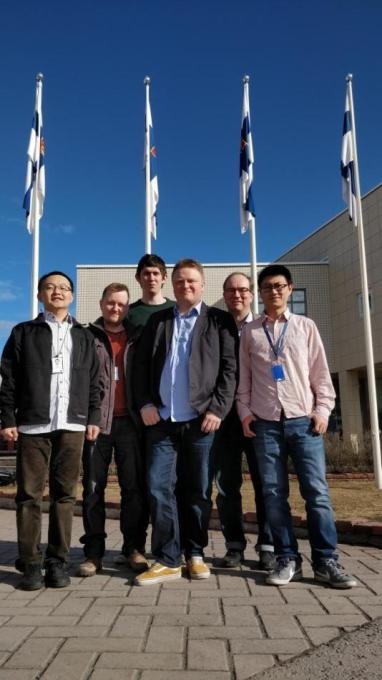Jun 6 2018
In the recent years, graphene has most definitely been the most prominent research subject of nanotechnology. Composed of pure carbon, this astonishing material is ideally easy to produce: taking normal graphite and peeling a layer using a Scotch tape. The material obtained this way is two-dimensional, with distinctive characteristics, varying from those of three-dimensional materials.
 The research group of the University of Oulu: Wei Cao, Sami Saukko, Sergei Posysaev, Marko Huttula, Matti Alatalo, and Xinying Shi. Missing from the photo: Vladimir Pankratov and Olga Miroshnichenko. (Image credit: University of Oulu)
The research group of the University of Oulu: Wei Cao, Sami Saukko, Sergei Posysaev, Marko Huttula, Matti Alatalo, and Xinying Shi. Missing from the photo: Vladimir Pankratov and Olga Miroshnichenko. (Image credit: University of Oulu)
However, graphene lacks one vital property — semiconductivity — complicating its use in electronics applications. Hence, researchers have begun their search for other two-dimensional materials with this desired characteristic. Molybdenum disulfide (MoS2) is one of the most propitious materials. Similar to graphene, MoS2 includes layers that have interactions with one another. Apart from being a semiconductor, the semiconducting characteristics of MoS2 vary based on the number of atomic layers.
If the MoS2 with one or few layers has to be useful in applications, it must be possible to join it with other components. What is hence required is a metallic conductor through which electric current can easily flow between the semiconductor and the conductor. For MoS2, nickel serves as a promising conductor, which also has other favorable properties from the perspective of applications.
However, an international collaboration, headed by the Nano and molecular systems research unit at the University of Oulu has recently found out that nanoparticles formed of nickel do not get attached to MoS2. What is required is gold, which has the ability to “glue” the conductor and the component together. According to docent Wei Cao of NANOMO, “The synthesis is performed through a sonochemical method.” Sonochemistry is a technique in which chemical reactions are initiated with the help of ultrasound.
The semiconductor and metal can be bridged either by the crystallized gold nanoparticles, or by the newly formed MoS2-Au-Ni ternary alloy.
Xinying Shi, Scientist, NANOMO
The electrical resistivity of the nanojunction thus formed is very small. It also retains the magnetic and semiconducting properties of MoS2. Moreover, the new material has favorable properties more than those of the original components. For instance, it functions as a photocatalyst, which is much more efficient when compared to pure MoS2. The golden nanojunction can be produced in an inexpensive and easy manner, rendering the new material appealing from the perspective of applications.